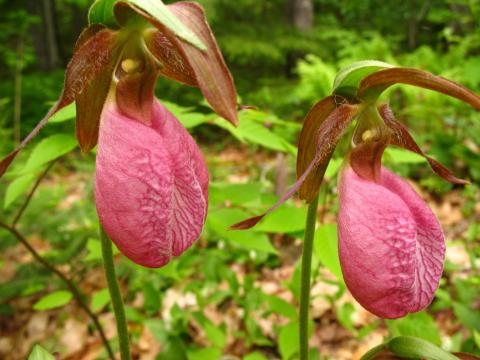Can you dig up pink lady’s slippers?

One of the most beautiful wildflowers in New Hampshire is the pink lady’s slipper (Cypripedium acaule). It is so widely revered that it was declared the official state wildflower in 1991. It is also one of the few native wildflowers that most Granite Staters have heard of and get excited about seeing in the woods in the spring.
Pink lady’s slippers are easily identified by their two opposite basal leaves with conspicuous parallel veins and large solitary pink flowers at the end of a long stalk. The plant gets its common name from the flower’s supposed resemblance to a woman’s shoe.
It is a long-standing myth that pink lady’s slippers are rare and that it is illegal to pick them, but this has been a very good thing for the species. Pink lady’s slippers grow in a narrow range of soil and climate conditions, making them very vulnerable to habitat destruction, climate change and over-picking.
They also do not transplant well or propagate from seed easily, and it can take a decade or longer for a plant to bloom for the first time. Though it is technically legal to dig up pink lady’s slippers on your own property and transplant them into your garden, such a practice is discouraged. Plants that are moved from one location to another often do not survive.
Pink lady’s slippers are a type of orchid and, like most other orchids, they rely on a specific fungus in the soil to germinate and grow. Pink lady’s slipper seeds do not have food stored within them like most other types of seeds. Instead, they require fungi to break them open and attach to them. The fungus passes on food and nutrients to the embryo within the seed, allowing it to germinate and develop into a plant.
As the lady’s slipper gets bigger and can produce most of its own food, the fungus will then take nutrients from the plant’s roots. This mutually beneficial “symbiotic” relationship is essential to the lady’s slipper’s survival. Plants that are dug up and transplanted are very unlikely to be successful, particularly in rich garden soils that bear no resemblance to the sandy, acid soils where pink lady’s slippers thrive in the wild. If the fungus is not present, then the orchid will fail to thrive and begin to decline or die, typically within a couple of years.
Additionally, if you ever see pink lady’s slippers for sale, it is pretty much a given that they were dug up from the wild. Propagating pink lady’s slippers is incredibly difficult and time-intensive, so they are rarely commercially propagated. If you would love to grow slipper orchids in your garden, choose a species that can be more easily cultivated, like greater yellow lady’s slipper (Cypripedium parviflorum var. pubescens) or showy lady’s slipper (Cypripedium reginae). Even these species are tricky to grow, and they come at a high price, typically $35 or more. Plants that sell for less were most likely collected from the wild.
For those interested in rare plants, the NH Natural Heritage Bureau maintains records on approximately 400 plant species determined to be endangered or threatened. This list includes several orchid species, such as small whorled pogonia (Isotria medeoloides) and dragon’s-mouth (Arethusa bulbosa).
Do you love learning about stuff like this?
SUBSCRIBE TO GRANITE STATE GARDENING
A monthly newsletter for New Hampshire gardeners, homesteaders and plant-lovers of all kinds, that includes seasonal suggested gardening tips, upcoming events and articles with proven solutions for your garden and landscape.
Got questions? The Ask UNH Extension Infoline offers practical help finding answers for your home, yard, and garden questions. Call toll free at 1-877-398-4769, Monday to Friday, 9 a.m. to 2 p.m., or e-mail us at answers@unh.edu.
